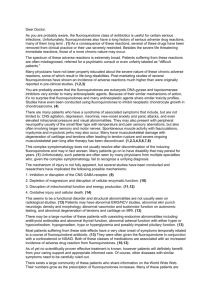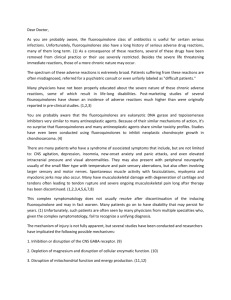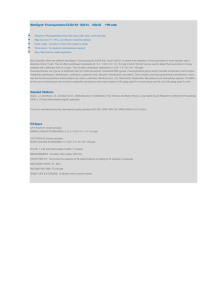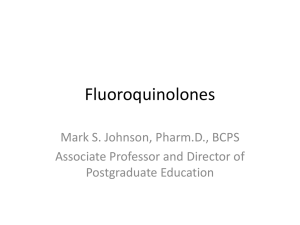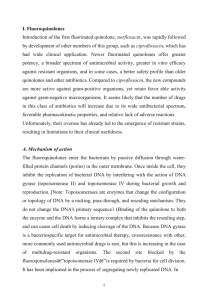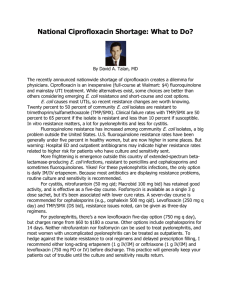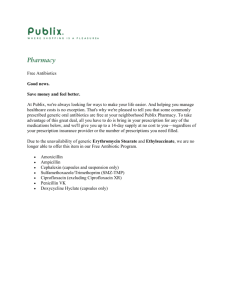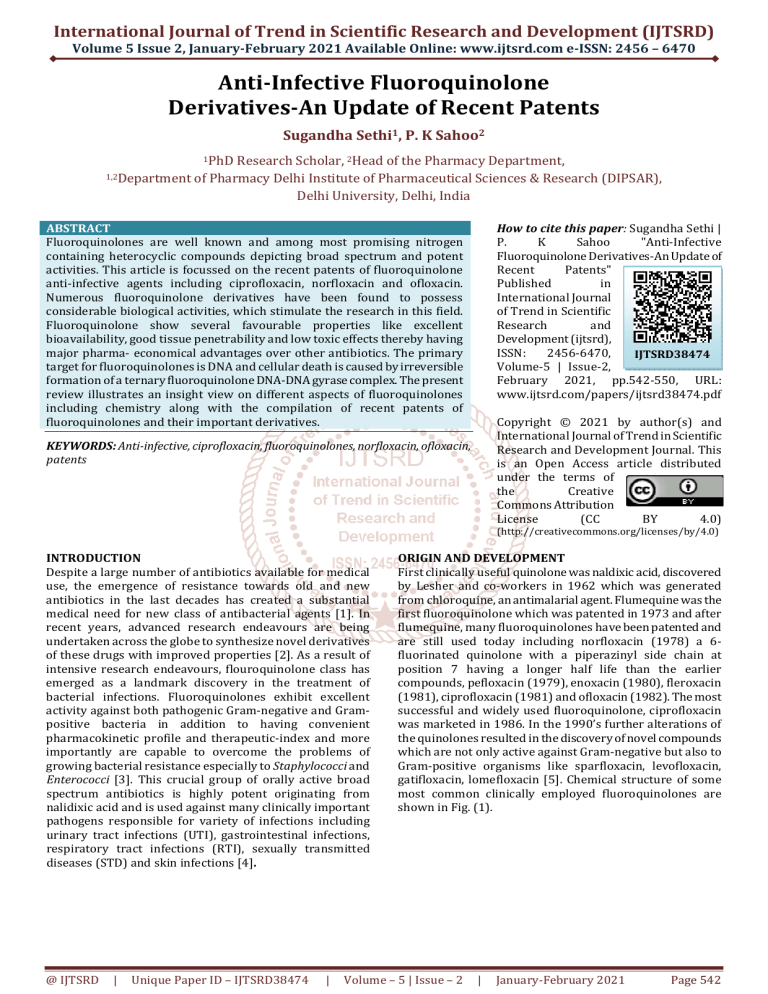
International Journal of Trend in Scientific Research and Development (IJTSRD) Volume 5 Issue 2, January-February 2021 Available Online: www.ijtsrd.com e-ISSN: 2456 – 6470 Anti-Infective Fluoroquinolone Derivatives-An Update of Recent Patents Sugandha Sethi1, P. K Sahoo2 1PhD Research Scholar, 2Head of the Pharmacy Department, 1,2Department of Pharmacy Delhi Institute of Pharmaceutical Sciences & Research (DIPSAR), Delhi University, Delhi, India ABSTRACT Fluoroquinolones are well known and among most promising nitrogen containing heterocyclic compounds depicting broad spectrum and potent activities. This article is focussed on the recent patents of fluoroquinolone anti-infective agents including ciprofloxacin, norfloxacin and ofloxacin. Numerous fluoroquinolone derivatives have been found to possess considerable biological activities, which stimulate the research in this field. Fluoroquinolone show several favourable properties like excellent bioavailability, good tissue penetrability and low toxic effects thereby having major pharma- economical advantages over other antibiotics. The primary target for fluoroquinolones is DNA and cellular death is caused by irreversible formation of a ternary fluoroquinolone DNA-DNA gyrase complex. The present review illustrates an insight view on different aspects of fluoroquinolones including chemistry along with the compilation of recent patents of fluoroquinolones and their important derivatives. How to cite this paper: Sugandha Sethi | P. K Sahoo "Anti-Infective Fluoroquinolone Derivatives-An Update of Recent Patents" Published in International Journal of Trend in Scientific Research and Development (ijtsrd), ISSN: 2456-6470, IJTSRD38474 Volume-5 | Issue-2, February 2021, pp.542-550, URL: www.ijtsrd.com/papers/ijtsrd38474.pdf Copyright © 2021 by author(s) and International Journal of Trend in Scientific Research and Development Journal. This is an Open Access article distributed under the terms of the Creative Commons Attribution License (CC BY 4.0) KEYWORDS: Anti-infective, ciprofloxacin, fluoroquinolones, norfloxacin, ofloxacin, patents (http://creativecommons.org/licenses/by/4.0) INTRODUCTION Despite a large number of antibiotics available for medical use, the emergence of resistance towards old and new antibiotics in the last decades has created a substantial medical need for new class of antibacterial agents [1]. In recent years, advanced research endeavours are being undertaken across the globe to synthesize novel derivatives of these drugs with improved properties [2]. As a result of intensive research endeavours, flouroquinolone class has emerged as a landmark discovery in the treatment of bacterial infections. Fluoroquinolones exhibit excellent activity against both pathogenic Gram-negative and Grampositive bacteria in addition to having convenient pharmacokinetic profile and therapeutic-index and more importantly are capable to overcome the problems of growing bacterial resistance especially to Staphylococci and Enterococci [3]. This crucial group of orally active broad spectrum antibiotics is highly potent originating from nalidixic acid and is used against many clinically important pathogens responsible for variety of infections including urinary tract infections (UTI), gastrointestinal infections, respiratory tract infections (RTI), sexually transmitted diseases (STD) and skin infections [4]. @ IJTSRD | Unique Paper ID – IJTSRD38474 | ORIGIN AND DEVELOPMENT First clinically useful quinolone was naldixic acid, discovered by Lesher and co-workers in 1962 which was generated from chloroquine, an antimalarial agent. Flumequine was the first fluoroquinolone which was patented in 1973 and after flumequine, many fluoroquinolones have been patented and are still used today including norfloxacin (1978) a 6fluorinated quinolone with a piperazinyl side chain at position 7 having a longer half life than the earlier compounds, pefloxacin (1979), enoxacin (1980), fleroxacin (1981), ciprofloxacin (1981) and ofloxacin (1982). The most successful and widely used fluoroquinolone, ciprofloxacin was marketed in 1986. In the 1990’s further alterations of the quinolones resulted in the discovery of novel compounds which are not only active against Gram-negative but also to Gram-positive organisms like sparfloxacin, levofloxacin, gatifloxacin, lomefloxacin [5]. Chemical structure of some most common clinically employed fluoroquinolones are shown in Fig. (1). Volume – 5 | Issue – 2 | January-February 2021 Page 542 International Journal of Trend in Scientific Research and Development (IJTSRD) @ www.ijtsrd.com eISSN: 2456-6470 CH3 F O F NH N N HOOC COOH N N N N N OH O O HN O N O CH3 F O S O F NH2 Sparfloxacin Ciprofloxacin CH3 O O N COOH F Prulifloxacin N C H HOOC N N F O H N N HN O HN N H H F N OCH3 H CH3 Grepafloxacin COOH Moxifloxacin Finafloxacin F O N S F HOOC N F N CH3 N O F CH3 COOH N O H3C H Rufloxacin NH N N CH3 HOOC Levofloxacin F O Temafloxacin Fig. (1). Some common clinically important fluoroquinolones CLASSIFICATION OF QUINOLONES Fluoroquinolones are classified as shown in Table (1) according to their pharmacokinetic profile and spectrum of activity [6]. Generation I II III IV Table 1 Classification of fluoroquinolones Fluoroquinolones Characteristic Feature Poor oral bioavailability, active against some Gram Flumequine, Oxolinic acid, Nalidixic acid negative bacteria and shorter half life. Better oral bioavailability with Improved activity Ciprofloxacin, Ofloxacin, Levofloxacin, against Gram-negative and Gram-positive cocci also Norfloxacin, Lomefloxacin, Marbofloxacin have longer half life Timafloxacin, Grepafloxacin, Sparfloxacin, Excellent oral bioavailability with lower central Tosufloxacin, Orbifloxacin nervous toxicities and fewer interactions with CYP 450. Gatifloxacin, Sitafloxacin, Prulifloxacin, Show extended activity against both strains of bacteria Trovafloxacin, Moxifloxacin and also active against anaerobes. CHEMISTRY O 5 F 6 N 7 HN O 4 1 8 N H 3 OH 2 Fig. (2). Basic fluoroquinolone nucleus @ IJTSRD | Unique Paper ID – IJTSRD38474 | Volume – 5 | Issue – 2 | January-February 2021 Page 543 International Journal of Trend in Scientific Research and Development (IJTSRD) @ www.ijtsrd.com eISSN: 2456-6470 The 6-fluoroquinolones are a series of synthetic antibacterial agents derived from, or related to nalidixic acid and oxolinic acid. Their basic nucleus is depicted in Fig. (2). Because of the presence of carboxylic acid and amine, these drugs are amphoteric in nature and considered zwitterionic. However, between the pKa of the acidic and basic functional groups (between pH 6-8), these compounds are sufficiently lipid-soluble to be able to penetrate tissues [7]. PHARMACOKINETICS AND PHARMACODYNAMICS Fluoroquinolones exhibit rapid but not always complete absorption after oral administeration. Oral bioavailability is 30 to 50% for norfloxacin, 70 to 80% for ciprofloxacin and upto 100% for ofloxacin and fleroxacin [8]. Presence of food in the GIT has little influence on the absorption of quinolones [9]. Fluoroquinolones differ widely in the degree to which they are metabolised and eliminated in the liver or by renal excretion. The metabolism is inactivating, and is primarily by glucuronide conjugation at the 3-carboxylic group. The piperazine ring is readily metabolized and this results in decreased antimicrobial activity [10]. They are eliminated by both renal and non renal routes but the primary route of elimination of most fluoroquinolones is through the kidney. A number of quinolones are cleared almost exclusively by glomerular filteration and tubular secretion, they are poorly cleared by both peritoneal dialysis and hemodialysis [11]. STEREOCHEMISTRY Fluoroquinolones having one or two chiral centers in their structures are available as racemates (ofloxacin, gemifloxacin, clinafloxacin), diastereoisomers (sparfloxacin) or pure enantiomers (levofloxacin, moxifloxacin). Stereochemistry significantly affects antibacterial activity. Grellet et al described that the S (-) ofloxacin isomer (levofloxacin) is 8–128 times more potent than R(+) ofloxacin [12]. Chu et al recognised the importance of proximity of chiral center in relation to its activity [13]. Chemical structures along with chiral centers of some chiral bicyclic fluoroquinolones (C*) are shown in Fig. (2). Machida et al separated the enantiomers of fluoroquinolones having carboxylic acid at position three by normal or reversed phase HPLC columns. They also prepared the L-valinamide diastereoisomeric derivative of gatifloxacin [14]. NH2 O F H3C * N HN * O COOH N COOH N F F N OCH3 HN * CH3 Cl COOH F N O Clinafloxacin Gatifloxacin O O F * N H2N * CH3 O N COOH N CH3 Sparfloxacin HN O F N F HN * CH3 F COOH COOH N N C2H5 H3C N N O * CH3 CH3 Flumequine Lomefloxacin Levofloxacin O O F H3CO N N N COOH F COOH N N N N F H2N * * NH2 F Tosufloxacin Gemifloxacin Fig. (3) Chemical Structure of some Chiral Fluoroquinolones (* Chiral Center) ADVERSE EFFECTS Gastrointestinal side effects such as nausea, vomiting and diarrhoea and central nervous system related side effects such as headache dizziness and insomnia are common adverse effects associated with fluoroquinolones reported in 2 to 20% of patients [15]. Khaliq et al carried out retrospective surveillance studies on fluoroquinolone-induced tendon injury in 98 cases and found that male patients with a mean age of 59 years are more likely to experience tendon injuries when receiving fluoroquinolones [16]. Torsade de pointes is a rare occurring disease due to long QT interval but potentially fatal arrhythmia. Fluoroquinolones have been reported to prolong the QTc interval and precipitate Torsade de pointes. Moxifloxacin has the potential to prolong the QTc interval, but Torsade de pointes is very rare [17]. @ IJTSRD | Unique Paper ID – IJTSRD38474 | Volume – 5 | Issue – 2 | January-February 2021 Page 544 International Journal of Trend in Scientific Research and Development (IJTSRD) @ www.ijtsrd.com eISSN: 2456-6470 RECENT PATENTS Over the past few decades there has been a large number of patent related activity in the field of anti-infective fluoroquinolones encompassing a range of various drugs including ciprofloxacin, norfloxacin, ofloxacin having various activities. The patents described here reveal the information regarding fluoroquinolones with novel approaches related to the area which provides potential for the development of therapeutic aspects. CIPROFLOXACIN Ciprofloxacin is the potent second generation fluoroquinolone active against a broad range of gram negative. Ciprofloxacin is marketed worldwide, with well over 300 different brand names. It is well absorbed orally and excreted mainly through the kidney. Ciprofloxacin is used in various infectious diseases mainly in urinary tract infections, osteomyelitis, gonorrhea, traveller’s diarrhoea, tuberculosis, prostatitis, community-acquired pneumonia, anthrax [18]. There are numerous patents related to ciprofloxacin which include development of several types of dosage form like inhalable formulations, liposomal powders, infusion, and topical suspension. Moreover various method of manufacturing and optimising have also been patented. List of important patents on ciprofloxacin is summarized in Table (2) [39-55]. Table 2 List of patents related to ciprofloxacin Sr. No 1 2 3 Date Patent number Invention disclosed Reference 23/06/2011 12/03/2009 04/12/2008 US 0150983 A1 US 0069339 A1 US 0300258 A1 39 40 41 4 14/12/2006 US 0280691 A1 5 20/10/2005 US 0232985 A1 6 14/10/2004 US 0202687 A1 7 29/04/2004 US 0082593 A1 8 11/12/2003 US 0229101 A1 9 24/04/2003 US 0078272 A1 10 07/01/2003 US 6503906 B1 11 14/11/2002 US 0169168 A1 12 28/03/2002 US 0037883 A1 13 28/03/2002 US 0037884 A1 14 19/03/2002 US 6359016 B2 15 17/07/2001 US 6262072 B1 16 12/10/1999 US 5965549 17 20/09/1988 US 4772465 Concentrated inhalable ciprofloxacin formulation Deuterium-enriched ciprofloxacin Anhydrous ciprofloxacin hydrochloride Spray freeze dried liposomal ciprofloxacin powder aerosol drug delivery Ciprofloxacin HCL Ciprofloxacin formulations and methods of making and using the same Infusion of ciprofloxacin having reduced acid content and being stable in storage Tablets comprising ciprofloxacin hydrochloride Methods of fluoroquinolone compounds against ciprofloxacinresistant and ciprofloxacin-sensitive pathogenic bacteria Method for optimizing ciprofloxacin treatment of anthrax-exposed patients according to the patient’s characteristics Pharmaceutical formulations of ciprofloxacin Process for manufacturing compositions containing ciprofloxacin and hydrocortisone Topical composition comprising ciprofloxacin and hydrocortisone Topical suspension formulations containing ciprofloxacin and dexamethasone Orally administered antimicrobial pharmaceutical formulations of ciprofloxacin Ciprofloxacin-hydrocortisone suspension Method of treating polymicrobial burn wound sepsis with a combination therapy of ciprofloxacin and Pseudomonas immune globulin 42 43 44 45 46 47 48 49 50 51 52 53 54 55 NORFLOXACIN Norfloxacin is an orally absorbed fluoroquinolone antibacterial with fluorine at position 6 and a piperazine ring at position 7. Specifically, the antibacterial spectrum of norfloxacin includes Pseudomonas aeruginosa as well as enteric pathogens. Norfloxacin is active against both penicillin-susceptible and penicillin-resistant strains of Neisseria gonorrhoeae [19]. The list of patents of norfloxacin is discussed in Table (3) [56-59]. Sr. No 1 2 3 4 Date 07/02/1989 20/12/1988 02/06/1987 05/11/1985 Table 3 List of patents related to norfloxacin Patent Number Invention Disclosed US 4803274 Norfloxacin intermediate US 4792552 Water-soluble adduct of norfloxacin US 4670440 Medicinal norfloxacin salts US 4551456 Ophthalmic use of norfloxacin and related antibiotics Reference 56 57 58 59 OFLOXACIN Ofloxacin is a broad spectrum second generation fluoroquinolone antibiotic which was first patented in 1982 [6]. Levofloxacin is the L-isomer of the racemate ofloxacin, a quinolone antimicrobial agent active against various bacteria including Grampositive and Gram-negative microorganisms and has been widely used for the cure of various infectious diseases [20]. Number of inventions of ofloxacin are disclosed and patented for e.g. ophthalmic formulations, topical preparation etc has been granted. These inventions along with their patent number are discussed in Table (4) [60-66]. @ IJTSRD | Unique Paper ID – IJTSRD38474 | Volume – 5 | Issue – 2 | January-February 2021 Page 545 International Journal of Trend in Scientific Research and Development (IJTSRD) @ www.ijtsrd.com eISSN: 2456-6470 Table 4 List of patents related to ofloxacin Sr. No Date Patent Number 1 09/12/2010 US 0310597 A1 2 12/08/2003 US 6605295 B1 3 08/07/2003 US 6589999 B2 4 28/03/1995 US 5401741 5 08/05/1990 US 4923862 6 02/05/1989 US 4826985 7 11/10/1988 US 4777253 Invention Disclosed Anti-ofloxacin monoclonal antibody and immunoassay of ofloxacin using the same Storage-stable opthalmic compositions comprising diclofenac and ofloxacin Antibacterial aqueous opthalmic formulations containing ofloxacin and use of chitosan for solubilizing ofloxacin suspended in an aqueous media Topical preparation for treating otopathy Reference Topical preparation containing ofloxacin Intermediates for preparation of racemate and optically active ofloxacin and related derivatives Process for preparation of racemate and optically active ofloxacin and related derivatives 64 60 61 62 63 65 66 MOXIFLOXACIN Moxifloxacin is a fourth-generation fluoroquinolone having in vitro activity against a wide range of Gram-positive and Gramnegative microorganisms, it binds both with bacterial DNA gyrase and topoisomerase IV enzymes which provide more effective bacterial killing and less bacterial mutation. Moxifloxacin was considerably more effective than ciprofloxacin against MRSA and MSSA. It was found highly active against K. Pneumonia isolates, which confirmed its uses in the treatment of respiratory tract infections [21]. Other patent of Fluoroquinolones There are several patents summarized below in Table (5) regarding fluoroquinolones including patents related to method of synthesis, various dosage forms of fluoroquinolones and for treatment of particular diseases [67-108]. Table 5 List of other patents related to fluoroquinolones Sr. No. 1 Date Patent Number 10/01/2012 US 8093381 B2 2 06/09/2011 US 8012711 B2 3 0 7/07/2011 US 0166126 A1 4 5 6 05/07/2011 30/06/2011 26/05/2011 US 7973022 B2 US 0160172 A1 US 0123626 A1 7 03/02/2011 US 0028444 A1 8 9 10 11 09/12/2010 23/11/2010 16/09/2010 01/07/2010 US 0311731 A1 US 7838532 B2 US 0234348 A1 US 0166673 A1 12 03/06/2010 US 0136523 A1 13 08/04/2010 US 0087386 A1 14 08/04/2010 US 0087416 A1 15 16 17 11/03/2010 18/02/2010 14/01/2010 US 0062974 A1 US 0037890 A1 US 0009979 A1 18 10/12/2009 US 0306128 A1 19 20 20/08/2009 25/06/2009 US 0209574 A1 US 0163484 A1 21 14/05/2009 US 0124632 A1 22 30/04/2009 US 0111991 A1 23 26/03/2009 US 0082337 A1 24 25 26/02/2009 08/01/2009 US 0054643 A1 US 0012072 A1 @ IJTSRD | Invention Disclosed Method of synthesis of fluoroquinolones Method of screening for compounds that reduce microbial resistance to fluoroquinolones Compositions and methods for modulating endophthalmitis using fluoroquinolones Fluoroquinolone carboxylic acid salt compositions Fluoroquinolone derivatives for opthalmic applications Pulmonary delivery of fluoroquinolone Pharmaceutically acceptable salts of anti-infection quinolone compounds Fluoroquinolone carboxylic acid molecular crystals Aerosolized fluoroquinolones and uses thereof Compositions and methods for potentiating antibiotic activity Aerosolized fluoroquinolones and uses thereof Molecular signature and assay for fluoroquinoline resistance in Bacillus anthracis Topical use of levofloxacin for reducing lung inflammation Aerosol fluoroquinolone formulations for improved pharmacokinetics Combination therapy for the treatment of bacterial infections Aerosolized fluoroquinolones and uses thereof Pharmaceuticals containing fluoroquinolones Pharmaceutical compositions containing a fluoroquinolone antibiotic drug Fluoroquinolone derivatives for opthalmic applications Pharmaceuticals containing fluoroquinolones Methods and kits related to the topical administration of quinolone antibiotics Coupling process for preparing quinolone intermediates Composition comprising quinolone and methods for treating or controlling infections Novel methods of synthesis of fluoroquinolones Fluoroquinolone compositions Unique Paper ID – IJTSRD38474 | Volume – 5 | Issue – 2 | January-February 2021 Reference 67 68 69 70 71 72 73 74 75 76 77 78 79 80 81 82 83 84 85 86 87 88 89 90 91 Page 546 International Journal of Trend in Scientific Research and Development (IJTSRD) @ www.ijtsrd.com eISSN: 2456-6470 26 11/12/2008 US 0306038 A1 27 20/11/2008 US 0287396 A1 28 12/06/2008 US 0138350 A1 29 23/08/2007 US 0196398 A1 30 25/05/2006 US 0110787 A1 31 32 25/11/2005 22/06/2004 US 0261165 A1 US 6753333 B2 33 05/02/2004 US 0023983 A1 34 35 36 37 23/12/2003 0 4/12/2003 09/05/2000 US 6667042 B2 US 0225119 A1 US 6060474 25/01/2000 US 6017912 38 15/06/1999 US 5912255 39 40 41 30/09/1997 08/07/1997 07/02/1995 US 5672600 US 5646163 US 5387748 42 11/12/1990 US 4977154 Compositions and methods for modulating inflammation using fluoroquinolones Phosphonated fluoroquinolones, antibacterial analogs thereof, and methods for the prevention and treatment of bone and joint infections Process for use of fluoroquinolones to reduce or modulate inflammation due to eye disease or opthalmic surgery Fluoroquinolone fatty acid salt compositions Use of fluorine-18-labelled fluoroquinolone antibiotics for diagnosing and monitering bacterial infection Method of reducing resistance to drugs Chiral fluoroquinolone arginine salt forms Methods of use of fluoroquinolone compounds against pathogenic helicobacter bacteria Flouroquinilone antibiotic product, use and formulation thereof Crystalline fluoroquinolone arginine salt form Method for preventing scar tissue formation Topical fluoroquinolone antibiotics in an alcohol and acetone vehicle Topical fluoroquinolone antibiotics combined with benzoyl peroxide Antimicrobial dithiocarbamoyl quinolones Quinolone 5-(N-heterosubstituted amino) antimicrobials Antimicrobial dithiocarbamoyl quinolones 5-amino and 5-hydroxy-6-fluoroquinoloes as antibacterial agents CURRENT AND FUTURE DEVELOPMENTS The future of the newer fluoroquinolones looks promising because of their unique mechanism of action. There is a great possibility of further developing novel and improved compounds in this class and the acceptance of these compounds as effective as well as therapeutic agents. In the current scenario of infections, new alternatives and progress are needed. As shown from the systematic literature survey, plenty of work has been done and patented by the number of investigators on fluoroquinolone moiety, yet further emphasis on examination of their impact is highly desirable. Therefore, it is clear that the development of newer therapeutics with a novel mechanism of action possessing superior efficacy and diminished potential for toxic effects appears to be a necessary requisite for treating the infections. Hence, across the globe, a ray of hope for new innovations and advancements are still rising. The patents described here reveal a wide range of novel approaches regarding several type of dosage forms, manufacturing, application and formulation etc that provide potential for the development of therapeutic effect of fluoroquinolones. Hopefully, newer and highly active anti-infective drugs would rapidly progress to various stages of development and enter the pharmaceutical market. REFERENCES [1] Kharb R, Sharma PC, Yar MS. Pharmacological significance of triazole scaffold. J Enzyme Inhib Med Chem 2010; 26 (1): 1-21. [2] [3] Sharma PC, Chaudhary M, Pahwa R, Sharma A, Dhamija M. Impact of stereochemical features on biological potential of fluoroquinolones. IJPI 2011; 1 (1): 1-10. Sharma PC, Jain A, Yar MS, Pahwa R, Singh J, Goel S. Synthesis and antibacterial evaluation of novel analogs of fluoroquinolones annulated with 6- @ IJTSRD | Unique Paper ID – IJTSRD38474 | 92 93 94 95 96 97 98 99 100 101 102 103 104 105 106 107 108 substituted-2-aminobenzothiazoles. Arab J Chem 2011; Doi: 101016/j.arabje.2011.04.008. [4] Sharma OP, Sharma PC, Jain S. Synthesis and antibacterial evaluation of novel fluoroquinolone derivatives. Int Conference Bioscience Biochemistry and Bioinformatics 2011; 1-5. [5] Sharma P, Kumar R, Chaudhary M, Sharma A, Rajak H. Synthesis and biological evaluation of novel benzothiazole clubbed fluoroquinolone derivatives. J Enzyme Inhib Med Chem 2011; 1-10. [6] Sharma PC, Jain A, Jain S. Fluoroquinolone antibacterials: a review on chemistry. Microbiology and therapeutic prospects. Acta Pol Pharm Drug Res 2009; 66 (6): 587-604. [7] Nikaido H, Thanassi DG. Minireview: Penetration of lipophilic agents with multiple protonation sites into bacterial cells: tetracyclines and fluoroquinolones. Antimicrob Agents Chemother 1993; 37: 1393-99. [8] Robson RA. Quinolone pharmacokinetics. Int J Antimicrob Agents 1992; 2: 3-7. [9] Rosenstiel VN. Quinolone antibacterials: an update of their pharmacology and therapeutic use. Drugs 1994; 47: 872-901. [10] Abraham DJ. Burger’s Medicinal Chemistry Drug Discovery. 6th ed. Wiley & Sons: New Jersey 2003: 582-87. [11] Fillastre JP, Leroy A, Humbert G. Ofloxacin pharmacokinetics in renal failure. Antimicrob Agents Chemother 1987; 31: 156-160. [12] Grellet J, BA B, Saux MC. High-performance liquid chromatographic separation of fluoroquinolone enantiomers: a review. J Biochem Biophys Methods 2002; 54: 221-33. Volume – 5 | Issue – 2 | January-February 2021 Page 547 International Journal of Trend in Scientific Research and Development (IJTSRD) @ www.ijtsrd.com eISSN: 2456-6470 [13] Chu DTW, Fernandes PB. Structure-Activity relationships of the fluoroquinolones. Antimicrob Agents Chemother 1989; 33 (2): 131-135. [14] Machida M, Izawa S, Hori W, Ishida R, Uchida H. Pharmacokinetics of gatifloxacin, a new quinolone and its enantiomers: II. enantioselective method for the determination of gatifloxacin and its application to pharmacokinetic studies in animals. Jpn J Chemother 1999; 47: 124- 30. [15] Oliphant CM, Green GM. Quinolones: A comprehensive review. Clin Pharm 2002; 65 (3): 455-464. [16] Khaliq Y, Zhanel GG. Fluoroquinolone-associated tendinopathy: A critical review of the literature. Clinical Infect Dis 2003; 36: 1404-10. [17] Altin T, Ozcan O, Turhan S, Ozdemir AO, Akyurek O, Karaoguz R et al. Torsade de pointes associated with moxifloxacin: A rare but potentially fatal adverse event. Can J Cardiol 2007; 23 (11): 907-08. [18] Sharma PC, Jain A, Jain S, Pahwa R, Yar MS. Ciprofloxacin: review on developments in synthetic, analytical, and medicinal aspects. J Enzyme Inhib Med Chem 2010; 25 (4): 577-89. [29] Shalit Itamar. Anti-inflammatory effects of moxifloxacin on IL-8, IL-1b and TNF-a secretion and NFkB and MAP-kinase activation in human monocytes stimulated with Aspergillus fumigates. J Antimicrob Chemother 2006; 57: 230-235. [30] Zimmermann S. Anti-inflammatory effects of antibacterials on human bronchial epithelial cells. Respir Res; 10: 89. [31] Guo-qiang. Design, synthesis and antitumor action of C3/C3 bis-fluoroquinolones linked-cross 2, 5-[1, 3, 4]oxadiazole 2010; 45: 1012-1016. [32] Sharma PC. Alawadhi N. Sharma A. Pahwa R. Rajak H. Fluoroquinolones in urinary tract infections: A study on perception analysis of prescribers. Der Chemica Sinica 2010; 1 (3): 84-90. [33] Shen G. Tsao TC. Kao S. Lee J. Chen Y. Hsieh W et al. Does empirical treatment of community-acquired pneumonia with fluoroquinolones delay tuberculosis treatment and result in fluoroquinolone resistance in Mycobacterium tuberculosis? Controversies and solutions. Int J Antimicrob Agents 2012; 39: 201-205. [34] Ziganshina LE, Squire SB. Fluoroquinolones for treating tuberculosis 2009. The cochrane collaboration 2009; 1: 1-58. [19] Sharma PC, Saneja A, Jain S. Norfloxacin: A therapeutic review. Int J Chem Sci 2008; 6 (4): 1702-13. [20] Khan AAP, Asiri AM, Azum N, Rub MA, Khan A, AlYoubi AO. Kinetics and mechanistic investigation of decarboxylation for the oxidation of levofloxacin by chloroamine-t in acidic medium. Ind Eng Chem Res 2012; 51: 4819-24. [35] World Health Organization, Department of Vaccines and Biologicals. Treatment of typhoid fever. Background document: the diagnosis, treatment and prevention of typhoid fever. 2003: 19-23. [36] Gao H, Pennesi ME, Qiao X, Iyer MN, Wu SM, Holz ER et al. Intravitreal moxifloxacin: retinal safety study with electroretinography and histopathology in animal models. IOVs 2006; 47 (4): 1606-11. Thaver D. Zaidi AKM. Critchley J. Azmatullah A. Madni SA. Bhutta ZA. A comparison of fluoroquinolones versus other antibiotics for treating enteric fever: meta-analysis. BMJ 2009; 338: 1-11. [37] Chung CW, Cohen EJ. Eye disorders: bacterial conjunctivitis. Clin Evidence 2000; 3: 305-310. [38] Haas W, Gearinger LS, Usner DW, DeCory HH, Morris TW. Integrated analysis of three bacterial conjunctivitis trials of besifloxacin ophthalmic suspension, 0. 6%: Etiology of bacterial conjunctivitis and antibacterial susceptibility profile. Clin Ophthalmol 2011; 5: 1369-1379. [39] Cipolla, D. C, Blanchard J. Concentrated inhalable ciprofloxacin formulation. US 20110150983 A1 (2011). [40] Czarnik, A. W. Deuterium-enriched ciprofloxacin. US 20090069339 A1 (2009). [41] Souza, F. E. S, Oudenes J, Ivanovich, G. Anhydrous ciprofloxacin hydrochloride. US 20080300258 A1 (2008). [42] Wang, Z, Orszanska, H., Finlay, W. H. Spray freeze dried liposomal ciprofloxacin powder aerosol drug delivery. US 20060280691 A1 (2006). [43] Janitzek, R. Ciprofloxacin HCL. US 20050232985 A1 (2005). [44] Babu, M. K. M., Thompson, R. P., Godiwalla, T. N. Ciprofloxacin formulations and methods of making and using the same. US 20040202687 A1 (2004). [21] [22] Domagala JM. Structure activity and structure–side effect relationship for the quinolone antibacterials. J Antimicrob Chemother 1998; 33 (4): 685-706. [23] Chu DT, Fernades PB, Claiborne Ak, Phiuleac E, Nordeen CW, Pernet AG et al. Synthesis and structure -activity relationships of novel aryl fluoroquinolone anti-bacterials. J Med Chem 1985; 28: 1558-64. [24] Tillotson GS. Quinolones: structure activity relationships and future predictions. J Med Microbiol 1996; 44: 320-24. [25] Patrick GL. An introduction to medicinal chemistry. 3rd ed. Oxford University Press: Oxford, 2005: 428-30. [26] Zhao X, Wang JY, XU C, Dong Y, Zhou J, Domgala J et al. Killing of staphylococcus aureus by C-8 methoxy fluoroquinolones. Antimicrob Agents Chemother 1998; 42: 956-58. [27] [28] Anquetin G, Rouquayrol M, Mahmoudi N, SantillanaHayat M, Gozalbes R, Greiner J et al. Synthesis of new fluoroquinolones and evaluation of their in vitro activity on Toxoplasma gondii and Plasmodium spp. Bioorg Med Chem Lett 2004; 14: 2773-76. Hamzah J, Skinner-Adams T, Davis T. M. E. In vitro antimalarial activity of trovafloxacin, a fourthgeneration fluoroquinolone. Acta Tropica 2000; 74: 39-42. @ IJTSRD | Unique Paper ID – IJTSRD38474 | Volume – 5 | Issue – 2 | January-February 2021 Page 548 International Journal of Trend in Scientific Research and Development (IJTSRD) @ www.ijtsrd.com eISSN: 2456-6470 [45] Sommermeyer, K., Muller, H. J., Hniopek, T., Eschenbach, B. Infusion of ciprofloxacin having reduced acid content and being Stable in Storage. US 20040082593 A1 (2004). [46] Sherman, B. C. Tablets comprising ciprofloxacin hydrochloride. US 20030229101 A1 (2003). [47] Appelbaum, P. C., Ednie, L. M. Methods of use of fluoroquinolone compounds against ciprofloxacinresistant and ciprofloxacin-sensitive pathogenic bacteria. US 20030078272 A1 (2003). [48] Lee, R. J. Method for optimizing ciprofloxacin treatment of anthrax-exposed patients according to the patient’s characteristics. US 20036503906 B1 (2003). [64] Hirota, S. Topical preparation containing ofloxacin. US 19904923862 (1990). [65] Mitscher, L. A., Chu, D. T. Intermediates for preparation of racemate and optically active ofloxacin and related derivatives. US 19894826985 (1989). [66] Mitscher, L. A., Chu, D. T. Process for preparation of racemate and optically active ofloxacin and related derivatives. US 19884777253 (1988). [67] Berthon-Cedille, L., Leguern, M. E., Renaud, G., Tombret, F. Method of synthesis of fluoroquinolones. US 20128093381B2 (2012). [68] Oethinger, M., Levy, S. B. Methods of screening for compounds that reduce microbial resistance to fluoroquinolones. US 20118012711 B2 (2011). [69] Ward, K. W., Zhang, J., Jonasse, M. S. Compositions and methods for modulating endophthalmitis using fluoroquinolones. US 20110166126 A1 (2011). [70] Murthy, Y. V. S. N. Fluoroquinolone carboxylic acid salt compositions. US 20117973022 B2 (2011). [71] Owen, G. R., Brooks, A. C., Bernal-Perez, L., Stroman, D. W., Dajcs, J. J. Fluoroquinolone derivatives for opthalmic applications. US 20110160172 A1 (2011). [49] Streuff, B., Luchtenberg, H. Pharmaceutical formulations of ciprofloxacin. US 20020169168 A1 (2002). [50] Singh, O. N. Process for manufacturing compositions containing ciprofloxacin and hydrocortisone. US 20020037883 A1 (2002). [51] Singh, O. N., Bhagat, H. G., Kabra, B. P. Topical composition comprising ciprofloxacin and hydrocortisone. US 20020037884 A1 (2002). [52] Singh, O. N., Bhagat, H. G. Topical suspension formulations containing ciprofloxacin and dexamethasone. US 20026359016 B2 (2002). [72] Weers, J., Tarara, T. Pulmonary delivery of fluoroquinolone. US 20110123626 A1 (2011). [73] Lee, F. Y. Orally administered antimicrobial pharmaceutical formulations of ciprofloxacin. US 20016262072 B1 (2001). Chen, M., Zhu, S., Zheng, L., Liu, X., Wang, Y., Xu, S. Pharmaceutically acceptable salts of anti-infection quinolone compounds. US 20110028444 A1 (2011). [74] Purwar, S., Goldman, D. Ciprofloxacin-hydrocortisone suspension. US 19995965549 (1999). King, H. M. Fluoroquinolone carboxylic acid molecular crystals. US 20100311731 A1 (2010). [75] Collins, M. S. Method of treating polymicrobial burn wound sepsis with a combination therapy of ciprofloxacin and Pseudomonas immune globulin. US 19884772465 (1988). Surber, M. W., Bostian, K. A., Dudley, M. N., Lomovskaya, O., Griffith, D. C. Aerosolized fluoroquinolones and uses thereof. US 20107838532 B2 (2010). [76] Cottarel, G., Gardner, T. S., Lei, X., Porco, J., Schaus, S. E., Wierzbowski, J., Pal, K. . Compositions and methods for potentiating antibiotic activity. US 20100234348 A1 (2010). [77] Surber, M. W., Bostian, K. A., Dudley, M. N., Lomovskaya, O., Griiith, D. C. Aerosolized fluoroquinolone and uses thereof. US 20100166673 A1 (2010). [78] Keim, P. S., Pearson, T., Price, L. B., Bush, J. D. Molecular signature and assay for fluoroquinoline resistance in Bacillus anthracis. US 20100136523 A1 (2010). [53] [54] [55] [56] Hermeez, I., Kereszturi, G. Norfloxacin intermediate. US 19894803274 (1989). [57] Simonovitch, H. Water-soluble adduct of norfloxacin. US 19884792552 (1988). [58] Sziits, T., Szentmiklosi, P., Lengyel, J et al. Medicinal norfloxacin salts. US 19874670440 (1987). [59] Katz, I. M. Ophthalmic use of norfloxacin and related antibiotics. US 19854551456 (1985). [60] Miyazaki, O. Anti-ofloxacin monoclonal antibody and immunoassay of ofloxacin using the same. US 20100310597 A1 (2010). [79] Bellmann, G., Claus-Herz, G Kessler, C. Storage-stable opthalmic compositions comprising diclofenac and ofloxacin. US 20036605295 B1 (2003). Dudley, M. N., Tsivkovski, R. Y., Griffith, D. C., Rodny, O. Topical use of levofloxacin for reducing lung inflammation. US 20100087386 A1 (2010). [80] Gurny, R., Felt, O. M. Antibacterial aqueous opthalmic formulations containing ofloxacin and use of chitosan for solubilizing ofloxacin suspended in an aqueous media. US 20036589999 B2 (2003). Griffith, D. C., Dudley, M. N., Surber, M. W., Bostian, K. A., Rodny, O. Aerosol fluoroquinolone formulations for improved pharmacokinetics. US 20100087416 A1 (2010). [81] LaRonde, F., Chen, H., Sinnadurai, S. Combination therapy for the treatment of bacterial infections. US 20100062974 A1 (2010). [61] [62] [63] Sato, K., Handa, A., Kitahara, T. Topical preparation for treating otopathy. US 19955401741 (1995). @ IJTSRD | Unique Paper ID – IJTSRD38474 | Volume – 5 | Issue – 2 | January-February 2021 Page 549 International Journal of Trend in Scientific Research and Development (IJTSRD) @ www.ijtsrd.com eISSN: 2456-6470 [82] Surber, M. W., Bostian, K. A., Dudley, M. N., Lomovskaya, O., Griffith, D. C. Aerosolized fluoroquinolones and uses thereof. US 20100037890 A1 (2010). [83] Heep, I., Fraatz, K., Hamann, H. J., Edingloh, M. Pharmaceuticals containing fluoroquinolones. US 20100009979 A1 (2010). [84] Campins, I., Jimenez, N., Vidal, R., Carreras, N., Martinez, C., Galan, F. J. Pharmaceutical compositions containing a fluoroquinolone antibiotic drug. US 20090306128 A1 (2009). [85] [86] [87] Owen, G. R., Brooks, A. C., Bernal-Perez, L., Stroman, D. W., Dajcs, J. J. Fluoroquinolone derivatives for opthalmic applications. US 20090209574 A1 (2009). Heep, I., Fraatz, K., Hamann, H. J., Edingloh, M. Pharmaceuticals containing fluoroquinolones. US 20090163484 A1 (2009). Babapour, R. Methods and kits related to the topical administration of quinolone antibiotics. US 20090124632 A1 (2009). [88] Reilly, M. Coupling process for preparing quinolone intermediates. US 20090111991 A1 (2009). [89] Venkastesh, S., Wang, H., Xia, E., Jonasse, M. S. Composition comprising quinolone and methods for treating or controlling infections. US 20090082337 A1 (2009). [90] Berthon-Cedille, L., Leguern, M. E., Renaud, G., Tombret, F. Novel method of synthesis of fluoroquinolones. US 20090054643 A1 (2009). [91] Murthy, Y. V. S. N. Fluoroquinolone compositions. US 20090012072 A1 (2009). [92] Zhang, J., Ward, K. W. Compositions and methods for modulating inflammation using fluoroquinolones. US 20080306038 A1 (2008). [93] Delorme, D., Houghton, T. ., Kang, T., Tanaka, K. . Phosphonated fluoroquinolones, antibacterial analogs thereof, and methods for the prevention and treatment of bone and joint infections. US 20080287396 A1 (2008). [94] [95] Murthy, Y. V. S. N. Fluoroquinolone fatty acid salt compositions. US 20070196398 A1 (2007). [96] Walker, R. C. Use of fluorine-18-labelled fluoroquinolone antibiotics for diagnosing and monitering bacterial infection. US 20060110787 A1 (2006). [97] Oethinger, M., Levy, S. B. Method of reducing resistance to drugs. US 20050261165 A1 (2005). [98] De souza, N. J. D., Agarwal, S., Patel, M. V., Bhawsar, S. B., Beri, R. K., Yeole, R. D., Shetty, N. Chiral fluoroquinolone arginine salt forms. US 20046753333 B2 (2004). [99] Chalker, A. F., Minehart, H. W. Method of use of fluoroquinolone compounds against pathogenic helicobacter bacteria. US 20040023983 A1 (2004). [100] Rudnic, E. M., Isbister, J. D., Jr., D. J. T., Wassink, S. E. Fluoroquinilone antibiotic product, use and formulation thereof. US 20036667042 B2 (2003). [101] De souza, N. J. D., Deshpande, P. K., Shukla, M. C., Mukarram, S. M. J., Kulkarni, D. G., Rahman, A. A. et al. Crystalline fluoroquinolone arginine salt form. US 20030225119 A1 (2003). [102] Williams, R. J., Hannafin, J. A. Method for preventing scar tissue formation. US 20006060474 (2000). [103] Bussell, L. Topical fluoroquinolone antibiotics in an alcohol and acetone vehicle. US 6017912 (2000). [104] Bussell, L. Topical fluoroquinolone antibiotics combined with benzoyl peroxide. US 5912255 (1999). [105] Jr., T. P. D., White, R. E. Antimicrobial dithiocarbamoyl quinolones. US 5672600 (1997). [106] Jr., T. P. D., White, R. E. Quinolone 5- (N– heterosubstituted Amino) antimicrobials. US 19975646163 (1997). [107] Jr., T. P. D., White, R. E. Antimicrobial dithiocarbamoyl quinolones. US 19955387748 (1995). [108] Sanchez, J. P., Trehan, A. K. 5-amino and 5-hydroxy-6fluoroquinoloes as antibacterial agents. US 19904977154 (1990). Bennett, M. D. Process for use of fluoroquinolones to reduce or modulate inflammation due to eye disease or ophthalmic surgery. US 20080138350 A1 (2008). @ IJTSRD | Unique Paper ID – IJTSRD38474 | Volume – 5 | Issue – 2 | January-February 2021 Page 550
